How a cesspool with overflow works: diagrams and construction technology
An independent treatment facility in a suburban area will allow the problem of waste disposal to be solved in the correct way.It is relevant for settlements not connected to central networks. If connection is not planned in the coming years, then a cesspool with overflow will be the best solution. A useful benefit of civilization will serve as an urban option. It's comfortable, don't you agree?
You will learn how to make a cleaning structure with an overflow by reading our article. It thoroughly examines the system design options and describes the construction technology. The advantages that an autonomous sewer system will provide are listed.
The information presented on the specifics of the construction of overflow cesspools and the features of their operation is based on regulatory documents and the experience of independent builders. Valuable and valuable additions to the text are useful photo collections, diagrams and video tutorials.
The content of the article:
Operating principle and device
The design of the simplest cesspool with an overflow well includes two objects connected to each other by a piece of pipe.
The first is a large-sized sealed container, constructed on the principle of a storage tank with impenetrable walls and bottom.
The second part of the structure is arranged in exactly the same way as the filtering version of the sewer well. This means that it does not have an impenetrable monolithic bottom. Instead of a solid concrete slab, a kind of filter with a thickness of 1 m or more is built in the area where the conditional bottom is constructed.
The filter is made in the form of a backfill made of materials with high filtration properties: crushed stone, slag, gravel and/or sand.
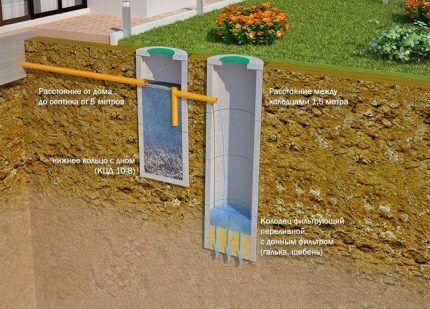
The walls can be made either solid or with holes to increase the rate of removal of processed waste from the filter well, otherwise called the absorption well.
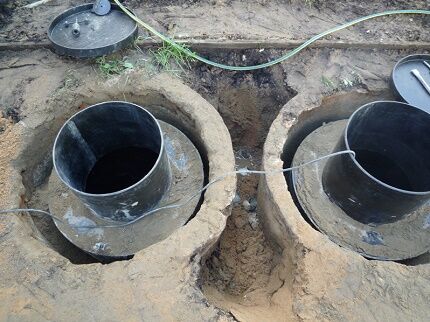
Connect the cesspool and filter well overflow - a tube located at an angle towards the absorber. The depth of its placement depends on the climatic data of the region, i.e. like any pipeline laid in the ground, the overflow must be below the level of seasonal freezing of the soil.
A sewer pipe is connected to the storage tank, through which wastewater will flow from the internal sewerage system into the storage tank.
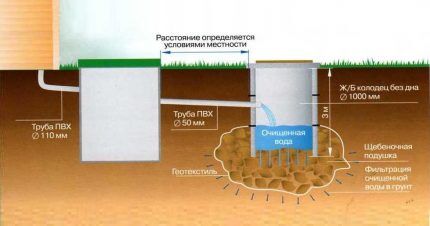
A ceiling with a hatch designed for pumping out the contents is installed above the cesspool. The ventilation pipe is mounted in such a way that the lower edge is above the drain horizon at any degree of filling. The second end of the pipe is brought to the surface.
For a cesspool with one filter well, you can build only one ventilation duct, but it is better to equip each compartment of a simple treatment plant with its own ventilation.
This design makes the wastewater treatment process more efficient and faster. First, all waste enters the first sealed chamber. Here they accumulate and decompose under the influence of bacteria. Gradually, there is more waste, the liquid level in the chamber rises and reaches overflow.

The insoluble part of the wastewater settles at the bottom, and the partially clarified with the participation of bacteria and settled liquid component, as it fills, reaches the level of the overflow installation and moves by gravity into the absorption well, in which the sewer mass is further purified.
In a filter well, wastewater passes through the drainage layer and enters the ground, once again being further purified through a natural earthen filter. And solid waste in the form of silt deposits accumulates in a sealed compartment of the cesspool, from which it is subsequently removed and, if desired, used by the owners as a starting material for preparing compost.
Why are such complications necessary, since it is easier to pump out the sewage mass from the cesspool and thus get rid of it? The presence of two containers significantly increases the size of the sewage system; part of the wastewater, after undergoing natural treatment, is transferred to the ground, due to which the number of calls for sewer trucks is significantly reduced.
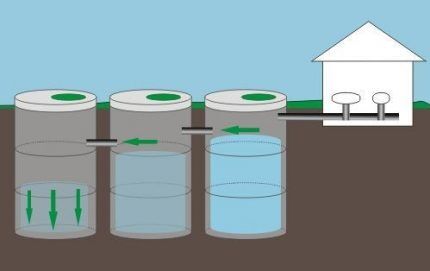
As the number of overflow wells increases, the scheme becomes somewhat more complicated. However, this increases the time from the receipt of waste into the container to the transfer of the liquid component into the ground. This makes it possible to improve the quality of wastewater treatment and make it safer for the environment.
Practice shows that a treatment plant consisting of two or more wells produces significantly less unpleasant odors than a conventional version of this type of construction. Usually there are either no odors or they are insignificant. It will help to improve the situation with the processing of sewage sludge and the elimination of odors. use of special bacteria.
The unpleasant squelching sounds that an overfilled cesspool makes are absent in a design with an overflow. Owners of such structures usually do not have to save sewer resources. They can enjoy the water without worrying about their sewer overflowing.
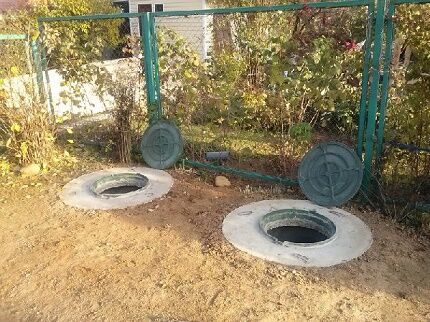
Numbers and basic standards
Before starting construction work, you should choose a suitable location for the pit with overflow. The standards for the distance of a structure from other objects on the site are approximately the same as for ordinary cesspool, since the problem of groundwater pollution is still relevant.
You should also take into account the characteristics of the soil on the site. The higher the permeability of the soil, the greater should be the distance separating thetwo-chamber cesspool from other buildings.
Depending on the type of soil, it is recommended to locate the sewerage structure at a distance from the residential building:
- not less than 15 m — for sandy, crushed stone, pebble and gravel soils;
- at least 10 meters - for sandy loams.
Cesspools with an overflow effect are installed only on soils with high filtration qualities. If the base of the absorption structure is supposed to be clayey, rocky or semi-rocky, the construction of a treatment facility of such a design will have to be abandoned.
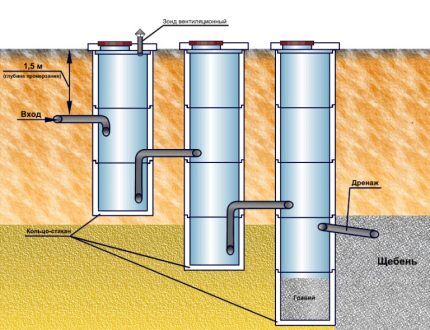
The space separating the source of drinking water and the sewage system must be solid:
- not less than 50 m - for sands;
- at least 30 meters - for sandy loams.
Since creating a structure consisting of two chambers takes more time and effort than when constructing a conventional cesspool, it makes no sense to make a small-volume structure. The minimum recommended capacity of the structure is 2 cubic meters. meters. Such parameters ensure sewerage capacity within 0.2-0.5 cubic meters. m/h.
When designing the structure, it is also recommended to take into account some parameters. For example, the optimal distance between the chambers of a cesspool is one meter. Although there are also structures in which the chambers are separated simply by a thick wall. There is a hole for the overflow in this adjacent wall. But this option is considered less effective.
It is recommended to give the overflow a standard slope for sewer pipelines to facilitate the movement of liquid waste into the filter well.The sewer pipe leading from the house is placed at a similar slope - 1.5 cm of height per meter of pipe is sufficient.
If the sewage system is installed correctly, there will be no problems with it. However, it is recommended to regularly check the filling level of the structure. If filters are installed inside the structure, their condition should be monitored at least once a month.
Options for construction of treatment facilities
When choosing a location for a cesspool, it is necessary to provide access roads for special equipment. If this is not possible, when installing a sewer system, you will have to manually perform extensive excavation work to dig a pit. It may turn out to be even more difficult and completely unpleasant. manual cleaning procedure storage facility for human waste.
To make a two-chamber cesspool, you can use a variety of tools. Of course, it is important that they provide tightness to the first compartment of the structure and permeability to the second. The most common version of such structures is cesspool made of concrete rings.
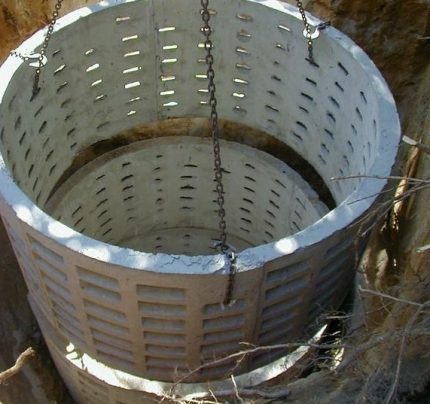
In the first chamber, the bottom is concreted, or a concrete slab is laid down; in the second chamber, the bottom is covered with a meter-long layer of filter material: crushed stone, gravel and/or sand. Suitable for the construction of a cesspool and brick. The bottom of the sealed brick compartment should also be concreted. Brickwork is done on this base.
The bottom of the second section of the cesspool is left free and, just as when using concrete rings, is covered with crushed stone or gravel.Actually, such a filtration layer is used in any version of the permeable section of the cesspool. The brickwork here can be done with gaps to make the walls permeable. This will reduce brick consumption and work time.

Another way to create a sealed cesspool is to fill it with concrete. To do this, it is necessary to make lathing and strengthen the walls of the structure with reinforcement. This is a rather labor-intensive and costly method and is not used often.
The possibilities for creating a filter part of a cesspool are more varied. Here you can install perforated plastic container or even do waste tire pit. Some used large galvanized containers installed in the pit at a distance from each other to construct both compartments.
When using available materials to create a sewer system, you should remember that they must be in contact with a damp and aggressive environment for a long time. Only those materials that are resistant to such conditions can be considered acceptable.
Three chamber design
If the dimensions of country estates allow, it is better to make not two, but three overflow wells to clean wastewater from one cesspool. All these departments, of course, are connected by an overflow. In this case, the distance between the chambers can be made smaller - only 70 cm. It is recommended that the size of each chamber, for example, the diameter of the concrete rings, be at least one meter.
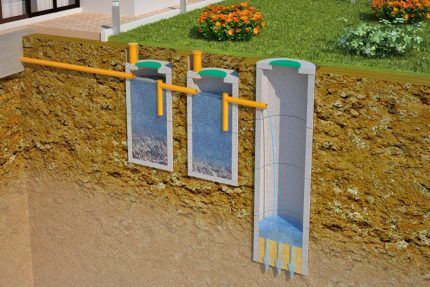
The first two wells are intended for processing wastewater, and the last one is for filtering the liquid component of the sewage mass that has undergone two stages of purification. Its bottom and/or walls are made permeable, as in the construction of a two-chamber sewer system.
Treated wastewater can be redistributed not only to underlying layers, but also discharged into sewer ditches or unused reservoirs. Effluent from a treatment plant can be transported to filtration fields through drains - pipes with holes for releasing the purified liquid component.
Drains are laid in sedimentary, non-cohesive soils of varying densities, preferably without layers of loam. The drainage system is constructed at a depth below the soil freezing level by the actual thickness of the pipe. The drains are covered with a layer of geotextile and then covered with crushed stone or gravel with sand filler.
The presence of three chambers increases the volume of sewage and significantly improves wastewater processing. The resulting liquid can be used for various technical needs, usually for irrigation.
Stages of construction of a monolithic system
Those wishing to fill monolithic concrete septic tank They will significantly save on costs, but construction will take much longer for those who decide to buy ready-made concrete rings. Briefly about the device process in the photo selection:
Installation procedure for a two-chamber pit
Work on the construction of a two-chamber sewer system begins with markings. It is necessary to determine the location and configuration of both pits.You can dig one large pit, install containers in it, and then fill the space between them with soil, but usually this only increases the costs and time of construction work.
Usually a pit is dug using an excavator. If you decide to dig by hand, use a shovel and a bucket on a rope to remove the soil. When using concrete rings, digging a pit can be done as follows: first, install a ring in the right place, then start digging inside, gradually undermining the soil under the walls of the ring.
Gradually the ring will descend down the cylindrical shaft. This method is especially appropriate on light soils, as it prevents the walls of the pit from collapsing. In all other cases, it is recommended to give the walls of the pit a slight slope so that they do not crumble or collapse.
After the pits have been dug, you need to arrange the bottom, i.e. fill it with concrete screed. Crushed stone is added to the solution to make the bottom more durable. If concrete rings have already been laid, then concreting is done inside the circle.
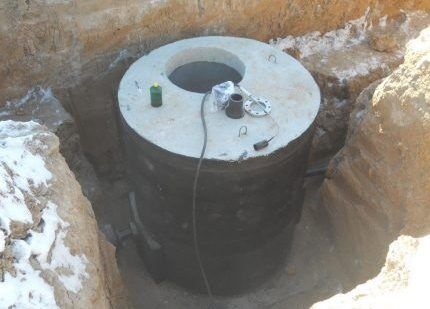
If it is decided to use a plastic container as a sealed chamber, the base for its installation is concreted. The container is lowered into the pit onto a hardened concrete slab and carefully covered with earth.
As you fill the container, it is recommended to gradually pour water so that a large amount of soil does not crush the structure.The water will balance the internal and external pressure.
In the second chamber, as already mentioned, instead of a concrete solution, a layer of filter material is poured. The technology for constructing this part of the structure is practically no different from the construction of a conventional absorption sewer well and depends on the type of material: brick, tires, wood, etc.
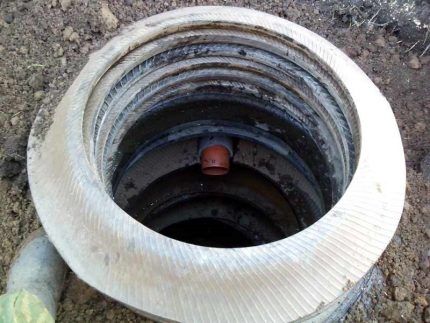
Now you need to connect a sewer pipe to the first chamber of the pit, and also install an overflow. The pipe is placed in the trench so that it is below the freezing level of the soil.
It is recommended to use thermal insulation materials as additional protection against freezing.
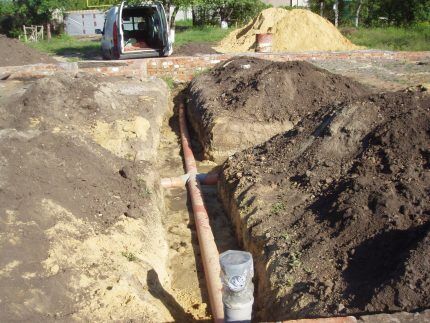
The overflow is also installed with a slope. It is made from a piece of plastic pipe with a diameter of 100 mm. The overflow is placed so that parts of the pipe protrude into the containers.
You can install perpendicular vertical sections of the same pipe on them to improve the operation of the sewer system.
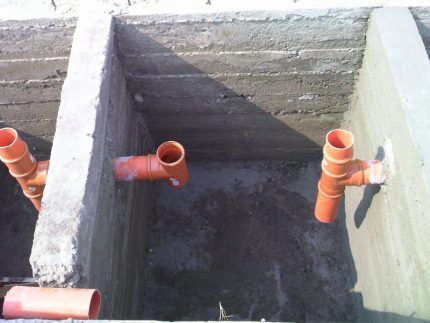
At the same stage, mesh filters are installed, which, as mentioned above, must be regularly inspected and, if necessary, cleaned. However, pits with overflow in the form of a simple piece of pipe also function quite successfully.
If water is drained from the filter well through additional drainage, this pipe should also be laid in the ground on a layer of crushed stone. Both chambers of the cesspool must be tightly closed. This is often done using concrete slabs with round or square service holes.
The holes are closed with special covers produced for sewerage installations. Now we need to solve the issue with ventilation. For a traditional storage-type cesspool, it is required in order to remove a significant part of the fetid gases from the container.
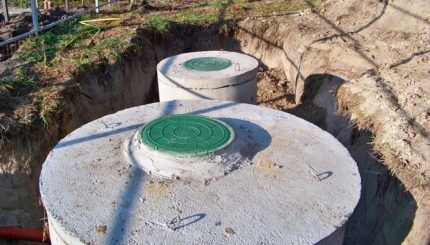
The method for removing methane gases generated during wastewater treatment depends on the type of bacteria involved in the construction. Some of them are already present in wastewater due to natural reasons, but the processing process is much more efficient if special bacterial preparations are added to the storage section of the sewer facility.
There are aerobic and anaerobic microorganisms. The former need a constant supply of fresh air, i.e. they function only in the presence of oxygen. Anaerobic bacteria do not need access to air. It is these microorganisms that can carry out the process of processing wastewater in a sealed container.
If it is still necessary to provide the sewer structure with ventilation, a special hole is made in the compartment lid to arrange it. A pipe with a diameter of about 100 mm should be installed in it. The top of the pipe is closed with a special conical cap to prevent precipitation from entering the cesspool.
The process of creating a cesspool structure consisting of three compartments is not much different from the technology described above. They just make three instead of two wells. Accordingly, three pits will be needed, not two. Both first compartments are sealed, and the last compartment is left permeable.
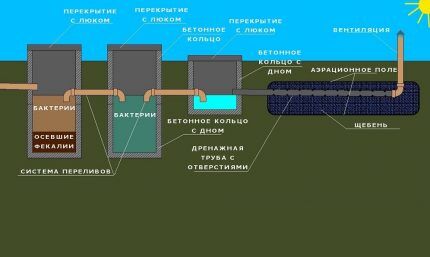
Produced industrial septic tanks also work on the principle of multi-stage wastewater processing using microorganisms. But they are considered more efficient, productive, and at the output they make it possible to obtain a significant amount of purified liquid suitable for technical use.
Installation of a septic tank is carried out by specialists and takes relatively little time. But given the cost of the structure, it should be supplemented with payment for installation services in order to have a complete picture.
Conclusions and useful video on the topic
The diagram for quick installation of a cesspool is clearly presented in the following video:
An overflow cesspool is, of course, a more modern and convenient version of a conventional cesspool. Of course, creating a two-chamber or even three-chamber structure requires more material costs, time and effort. But all this will more than pay off in the future, when the residents of the house feel the effect of using a reliable sewer system that requires minimal maintenance.
If you have experience in constructing overflow cesspools or have already encountered this issue and have something to share with our readers, please leave your questions or valuable tips below in the comments.




Hello! I appeal to those who have already managed to successfully make a cesspool with an overflow on their own. I’m planning to start building it at my summer cottage, but I’m afraid it will cost me a pretty penny. How much money can be spent on the necessary materials and the work itself? P.S. There are no deadlines.
Vasily, in general, your question, unfortunately, has no answer, since you did not indicate what materials you want to use, depth, etc.
I can tell you how to save money using the example of my friend. The septic tank cost 40 thousand “turnkey”. A local tractor driver dug with it and he found a manipulator to go pick up the rings bought from an ad. Again, they bought other materials, pipes, there. The result is 20 thousand. But regional prices for everything sometimes differ greatly.
But, again, you can dig a hole yourself, a trench... You can throw in wheels, a plastic container. Then, really, five thousand will work out on a budget. My friends simply did it thoroughly, for a large family and for permanent, and not country use, like yours.
Nikolay, good afternoon. We have the same problem, we dug out a septic tank that was overflowed from 3 containers. But there is water in all three!(((We have already concreted several times... Still, the water is gradually gathering. We can’t start it. The soil is clay. Can you tell us our mistake?
You can spend two thousand rubles, from which you will need to buy a cylindrical metal container with a diameter of 1.5 meters, a depth of 2.5 meters and a plastic pipe - drain.You need to make a lot of holes in the container with a grinder to allow the liquid to seep into the ground, and in the second hole 2x2 meters, throw crushed stone on the bottom almost to the top, and on top of pebbles or stone - rubble, the second hole will never be filled. This type of sewer system itself: I pump it out once every 7 years, only from the first pit!
Hello. Not always relevant. If the groundwater level throughout the entire area is high, as, for example, in our dacha, filling the second pit will be frequent seasonally, and the pebbles will prevent the use of the pump.
Last year it was necessary to expand the cesspool. I had to suffer for quite a long time, since everything was done by hand and from scrap materials. I dug a hole and used large old tires to build the chamber. The biggest problem was that the hole was dug 7 meters from the existing one, since there was no room. And the main difficulty was connecting the pipe. It was not easy, but I still managed to complete the task.
Is 7m not enough for overflow? I have a similar problem, I’m considering the option of overflowing, but the distance from the existing hole (old) will also be about 7-8m, isn’t that too much?
Good day, Sergey. No, it's not much. The distance is determined based on terrain conditions. The main thing is to maintain the slope, see Figure 1. Pay attention to the change in parameters depending on the diameter of the pipes.
Since the planned distance is quite large, you should not neglect the standards. Too much slope can lead to blockages because the water flow will move at a higher speed, not having time to carry feces/large waste down the drain.
The exit point of the pipe from the first container will most likely be located above the freezing point of the soil, so it is advisable to insulate at least the first 4 meters.
Do not forget also about preparing a sand cushion under the pipe along its entire length.
Hello. In general, it is desirable that the distance be a minimum of 0.5 m. Since wastewater, containing fat and other substances, can settle on the walls of the pipes, which will not be easy to clean. In addition, more careful insulation of the pipe will be required; freezing in winter is possible with little water flow. But if space doesn’t allow, there’s nothing you can do about it.
Hello! Tell me, I saw this on some diagrams... Why do they arrange an overflow at the bottom of a two or three chamber septic tank? It’s clear from above, but why below?
Dinara, I’ll assume that the overflow in the lower part is done to save on filling silty fecal waste, which, as a rule, settles to the bottom. It turns out that they are poured into another barrel and go to the filter bottom.
Good afternoon, Dinara. Look, any septic tank requires maintenance, and it consists primarily of pumping out the silt deposits that accumulate at the bottom.
The overflow in the lower part is designed to increase the usable area, thereby reducing the frequency of pumping out sediments. This scheme allows you to call the sewer truck less often, saving your family budget.
Hello, tell me, will you eventually have to pump out the water from the pit? The point is that we want to use such a system for a coffee shop, purely for kitchen waste, but we won’t be able to drive up to the coffee shop for pumping out, since this is a park area. Or maybe there is an option where we can do without pumping because the amount of kitchen waste will be small?
Please advise. The pit at the purchased dacha is a concrete ring, 2.5 m in diameter, approximately 1.2 m high, installed without a sealed bottom. Obviously for construction waste.. Alluvial soil. Drainage has stopped. Would it be effective to install an overflow and a filter well nearby for less frequent pumping?
Hello, please tell me how much lower the overflow pipe should be relative to the sewer pipe. Is this regulated in any way? And is it possible to seal the holes with foam? The builders sealed it with foam and made the pipes at the same level. I understand the “reliability and performance” of such a shambo, but I just can’t get them to correct it, I don’t know what to refer to, but they say nothing is regulated.
Good evening !
Please tell me I’m alone and I don’t understand how to properly build a septic tank, everyone says different things...
While there is a hole for a septic tank of three rings, they are offering a second pit of 5 rings nearby, is this correct!??
And how is it correct?
Thank you !
Hello!
Experts write that it is impossible to build an overflow on clay and high groundwater. Question 1: is it really impossible to achieve absolute tightness of wells from groundwater using, for example, polymer sand rings?
Question 2: if the answer to the previous question is “possible,” then it’s also possible to make the last well sealed and simply force liquid out of it once it’s full?